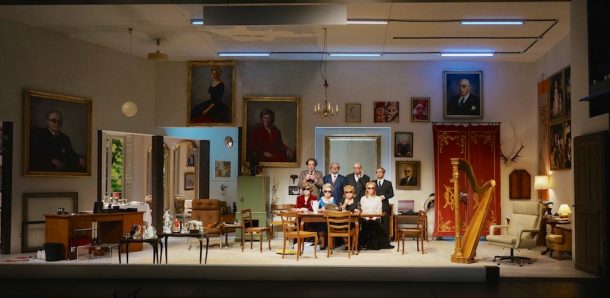In Ce ne andiamo per non darvi alter preoccupazioni (“We decided to go because we don’t want to be a burden on you”), by Italians Daria Deflorian and Antonio Tagliarini from Rome, the players revisit the story of four Greek retirees – all women in their 60s – who decided to commit suicide together so as not to be a bother to society or to their friends. This was a story found in the first chapter of Petros Markaris’s 2011 crime novel, The Settlement. Early on in their show, the actors talk about their struggle to find a way to deal with this material. Is this suicide a generous gesture or a desperate act, they wonder. How can they recreate and dramatize this story? They hesitate until they realize that these “ordinary” women could have found ways to go on with their lives, but that they decided instead to say a resounding, “No.” “No,” to the possibility of just making do, “No,” to putting up with things as they are, and “No,” to the chaos and devastation of Greece’s economic crisis. Their “no” is a powerful act of resistance.
A number of the shows at this year’s festival also said, “No.” Christoph Marthaler’s Une île flottante , a wild farce, which mocks the posturing of two middle-class families caught up in trying to outdo each other in terms of their social status, says, “No” to bourgeois pretensions and the lack of humanity on the part of these pompous individuals. In Pluton – acte 2, well-known dancers Paul-André Fortier and Louise Bédard refuse to give in to the inevitable toll of aging. Even though they are no longer in their prime, they perform beautifully crafted pieces created for them by members of a younger generation. Fortier’s open arms and graceful movements speak of acceptance and welcoming the inevitable, while Bédard’s tortured, defiant presence declares her refusal to give up as she thumbs her nose at the pain she must feel.
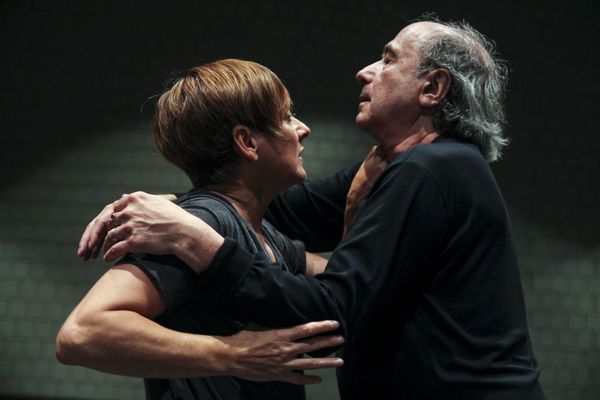
A Scene from Pluton – acte 2, featuring Paul-André Fortier and Louise Bédard, 2016. Photo Courtesy: Festival Transamériques.
The ventriloquists’ puppets featured in Gisèle Vienne and Dennis Cooper’s The Ventriloquists Convention, say, “No” to their handlers in protest against being controlled and manipulated by these self-promoting individuals. Trajal Harrell and his splendid dancers repeatedly say, “Don’t stop! Do not stop! Do not stop!” as they question the relationship between modernism and voguing, and create thrilling new work, while Halifax artists Stewart Leger and Christian Barry’s hybrid piece Let’s Not Beat Each Other To Death, inspired by the killing of a gay rights activist, shouts, “No” to violence in all of its forms.

A Scene from Let’s Not Beat Each Other To Death, directed by Stewart Leger and Christian Barry, 2016. Photo Courtesy: Mel Hattie.
The remarkable Ce ne andiamo per non darvi alter preoccupazioni takes the form of an investigation composed of bits and pieces, a reconstitution, questions about motives, and an overwhelming need to discuss the economic crisis in Italy, as well as to understand what the picture of the bodies of four Greek women who voluntarily took their lives together, tells them in the context of the economic crisis in Greece. Joined by Monica Piseddu and Valentino Villa, Taliarini and Deflorian set out to explore the complex meaning of this suicide.
The stage is bare but for a neon light overhead. Dressed in everyday clothes, Deflorian and Tagliarini come forward to share with us the difficulties they experienced in trying to make their fascinating theater piece. “We are not ready,” Deflorian confesses. “We were thinking we might not do it. It’s not like we haven’t worked on it. But we got lost in some mental gymnastics. And didn’t come up with any action so…. we wondered what the point of doing it in front of you is.” “How can you act out the experience of death and not make it overly dramatic? Who are we to represent this story?,” they ask. Inspired by the importance of saying, “No,” they know they must develop something. So, they begin. Two women and two men will share their possible solutions to this puzzle for one all-too-brief hour.
Sitting on a straight-back chair, Monica imagines being in a room in the outskirts of Athens, on the edge of a world in ruins. Everything is tidy, shiny and clean. The TV is on. You go into the next room, she continues, where there is a double bed with two old women lying there staring at their slippers. Their skirts are straightened out like good housewives. A note on a table explains why they came to their decision. We learn that the four pensioners did not want to weigh on those who are alive. After all, they live alone, have no children and no dogs. “First, they cut our pensions, our only source of income. Then, the doctors were on strike, and they had to pay for their prescriptions because the Health service was in debt. You’ll save on our four pensions and live better. “
The only thing out of place in this neat dwelling is the half empty vodka bottle on the kitchen table. Sleeping pills with vodka, the surest way to go off quietly in your sleep, one of them observes. Four ID cards placed conspicuously on a table make a clear statement that these women are not anonymous. They have names and biographies.
As the performers continue to explore the women’s reasons for taking their lives, they enter and leave their characters as they move from the shadows into the light at the center of the stage. Sitting on chairs or lying on the floor, they listen intently to what each one has to say about why they decided to die. One talks to herself, as she lies on the floor staring up at the ceiling and imagining that dying is like going to sleep.
Another tells us that she can do dying, but the real problem is how she can turn her death into a political action. It’s not like Jan Palach, a student who set himself on fire at twenty-one in a square in Prague to protest against his country being invaded. That would be over-dramatic whereas Deflorian and Tagliarini are interested in ordinary, unpretentious lives.
One of them is angry at herself, but wishes she could get angry with something outside of herself. She is in control during the day and goes to bed exhausted. Then at 4 a.m., she suddenly wakes up and realizes she has no safety net. What will she do when she’s 60 or 70?
It is clear that these women will not change their minds even though they express some reservations and concerns. “Who will come to my funeral?” “What if the sleeping pills don’t work?” They could have gone on sizing down and cutting stuff out in order to make ends meet, but they realize that there’s no reason to put up with things as they are. “Enough is enough.” Interestingly, one of them teaches Greek to immigrants and admits that she loves life. “My financial problems are not my life,” she admits.
There are regrets and moments of humor. One wishes she could have danced the Sirtaki even if it’s just a folk dance invented for the film Zorba the Greek, while another almost giggles at the thought that she got away with not paying her fines. And another tells us that a dear, sweet friend of hers invited her to live with her. “We’ll live together,” she said. “We’ll help each other and keep each other company. “ Her response, “I’d rather shoot myself,“ evokes a welcome moment of laughter from the audience.
In the final scene, the four women seem to have achieved serenity. They are no longer moving anxiously about. Perhaps, they have accepted the power of refusal. We do not feel pity for them. Instead we admire their courage and determination. They are at peace.
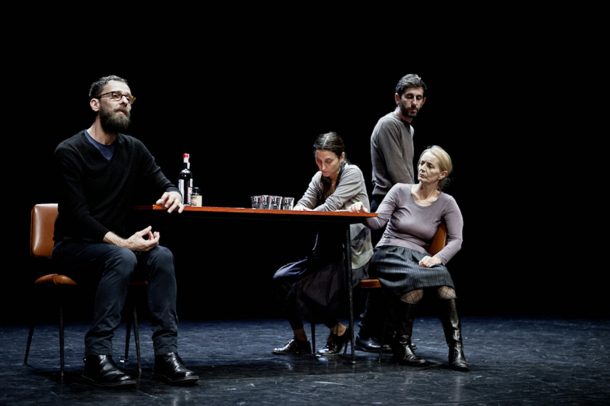
A Scene from Ce ne andiamo per non darvi alter preoccupazioni, directed by Daria Deflorian and Antonio Tagliarini, 2016. Photo Courtesy: Festival Transamériques.
In an entirely different vein, Swiss director Kristof Marthaler’s A Floating Island, a bi-lingual vaudeville farce, offered audiences over two hours of a hilarious send up of the manners and pretenses of two bourgeois families, the Malingears and the Ratinois. Loosely adapted from Eugène Labiche’s 1861 comedy La Poudre aux Yeux, Marthaler’s comedy is an explosive non-stop romp overflowing with visual and physical gags, pranks, and craziness. In scene after scene, Marthaler mocks the posturing and inanity of these two families trying to outdo each other.
For starters, the play’s two families can’t even understand each other. The Malingears speak only French while the Ratinois speak only German. This of course leads to numerous moments of total confusion which they seem to take in their stride.
The play opens at the Malingears’s bourgeois drawing room. Pompous looking ancestors clutter the walls along with prints and masks. There is even an empty frame in which a woman smoking a pipe will suddenly appear later on. The room is overflowing with furnishings including an impressive harp, instead of the piano in Labiche’s comedy. Dr Malingear sits behind his desk on one end of the stage while his wife reads in a chair across the room. Recalling Ionesco, the clock strikes numerous times as he slowly addresses his wife with, “Bonjour, ma femme. C’est moi.” He is pleased that business is picking up. He has a new client, he proudly tells her, a coachman whose horse kicked him. Madame Malingear is not impressed. Their daughter Emmeline is not happy that Frederic Ratinois, her music teacher, has not yet proposed to her. His parents have organized a fancy dinner party to meet their potential in-laws.
The butler, British actor Graham Forbes Valentine, comes in carrying a stuffed porcupine and crosses the room. He will frequently carry around stuffed animals and place them in specific areas, adding to the already cluttered room. He also controls the music and sound effects with a remote control. A woman in a catatonic state, Friedelind, drifts through the play claiming to be stuck in time. Frederic comes in, an equally strange character whose crooked walk and unkempt appearance seems a perfect match for Emmeline who has buck teeth and prominent corkscrew curls on the top of her head.
As the families gather for dinner, the fun begins. When it comes the time for Malingear and Ratinois to announce their children’s engagement, each speaks in his native language. It is hilarious. At another time, Ratinois has a long speech composed of meaningless sounds, and for no reason, the butler suddenly bursts forth with a virtuoso recitation of Lewis Carroll’s “Jabberwocky.”
Pratfalls, a staple of farce, abound throughout the play. Malingear falls through the seat of his chair, with his pants wrapped around his ankle and he can’t get out. Frederic experiences the same fate. He is so stuck in his chair that he has to be pulled out of it. Emmeline ends up with bloody fingers due to the porcupine quills she uses to do her sewing. Strange sounds emanate from the characters from time to time. They snort like pigs or have coughing fits.
Act II finds the women seated at the dinner table wearing dark glasses for reasons unknown. The men stand behind them as if posing for a family portrait, a portrait of a family who is anything but distinguished. They are all dabbing their noses with white handkerchiefs trying to stop the nosebleeds they’ve no doubt acquired from all the running around. None of them show any affection for one another. Even when Dr Malingear and Madame Malingear dance together, he doesn’t move an inch while she does her two-step looking thoroughly bored.
They seem to enjoy making meaningless declarations with straight faces such as, “My husband snores a little” or, “I do not smoke,” apropos of nothing. And they get pleasure out of singing. In the end, the characters pack up the scenery and the props and leave. The stage is completely empty, as if they never existed.
As festival director Martin Faucher says, “The economic crisis has provoked a crisis of identity and values.” His 2016 program addressed this crisis in multiple forms, especially Une île flottante, whose title suggests a dessert made of egg whites floating on a crème anglaise, delicious and delightful but empty.
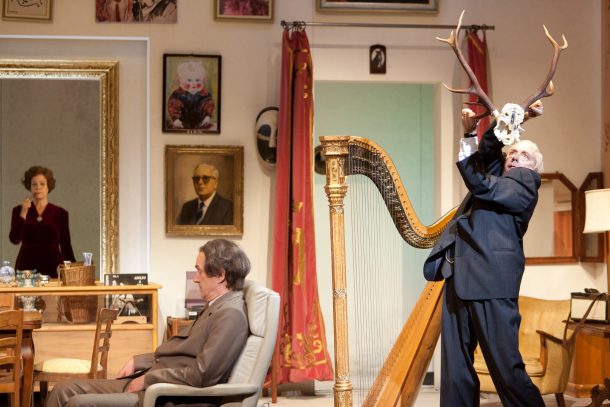
A Scene from Une île flottante, directed by Christoph Marthaler, 2016. Photo Courtesy: Theater Basel.
The Ventriloquists Convention by French-Austrian artist Gisèle Vienne, in collaboration with American writer Dennis Cooper and the Puppentheater Halle, takes the annual international ventriloquists’ convention in Kentucky as its source of inspiration to create a gallery of types, both human and artificial, whose voices create a layered vocal score, composed by Cooper.
As the show begins, a group of puppeteers gather in a large room to attend the ventriloquists’ convention. A few lifeless dummies are sprawled on chairs, left to themselves as their animators are busy meeting and greeting. When Nils Dreschke rushes in with a, “Sorry I’m late,” all eyes turn to him. He is just back from Las Vegas where he has landed a lucrative five-year contract to perform at a well-known casino there. His fellow ventriloquists/puppeteers applaud and shout, “Bravo!” as he and his puppet who looks and dresses exactly like him, take over the microphone. He is arrogant, loud and self-absorbed. His thinly disguised distain for his fellow artists is obvious. They may clap and approve, but before long, their enthusiasm will turn into a power struggle amongst each other as well as their puppets.
Whereas a convention should be a place to gather and establish professional networks, Vienne’s is a fictional reconstitution designed to reveal what is behind those dissonant voices creating a unique form of dialogue. It allows for the full vocal expression of different strata of language, and thus of thought.
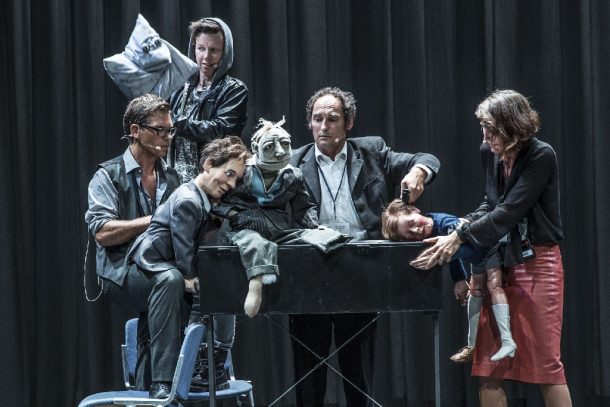
A Scene from The Ventriloquists Convention, directed by Gisèle Vienne and Dennis Cooper, 2015. Photo Courtesy: Internationales Sommerfestival, Kampnagel.
The ventriloquists and their puppets are a varied group. There is Sebastian Urtak and his puppet, Kurt Cobain. Dressed in dirty jeans, sneakers, and a plaid shirt, with messy hair covering his face, Kurt is a sad-sack of a fellow. Ines is the hospital ventriloquist in charge of entertaining terminally ill children who surely must be upbeat at all times. Kerstin, the orphaned daughter of a famous ventriloquist, has brought her father’s puppet with her to try out a new routine about her relationship with her father, but can’t seem to achieve what she wants. Lutz is aroused and enjoys telling everybody about his erection. Jonathan Capdevielle’s puppet is an impressive preying mantis, who gives birth to a baby fathered, he says, by Nil’s dummy who had date-raped her months before. And Lars Frank is determined to get his puppet to sing. The puppet rebels to the best of his ability but his manipulator inevitably wins by beating him to submission. The song Lars sings is a sad one indeed. Still, the puppet gets his revenge in a biting monologue about Frank’s depressed, lonely life.
The best of the lot is Uta Gebert’s puppet, a pillow with bright eyes and a sweet smile. Unfortunately, Uta has trouble getting Pillow to perform. Kurt Cobain comes over and asks her to sleep with him. When she refuses, he commits suicide.
The convention ends with a story told by Jonathan Capdevielle’s drag character Jessica, about how she came to be a ventriloquist and puppeteer. She discovered her homosexuality at an early age and learned to cope with being a gay outcast by inventing an imaginary friend, a “puppet” with whom she bonded.
Ultimately, all of the puppets must die. Pillow gets her stuffing brutally pulled out of her and Cobain hangs himself. Clearly their revolt was not a success. Indeed, how could it be? Puppets, by definition, are dependent on their manipulators. They did their best to say, “No.” Alas, their voices were heard for only a short while, and even then, their voices were artificially produced by their ventriloquists. Unlike the four women in Ce ne andiamo per non darvi alter preoccupazioni, they did not have a choice.
Philippa Wehle is Professor Emerita of French Language and Culture and Drama Studies at Purchase College, State University of New York. She writes widely on contemporary theatre and performance and is the author of Le Théâtre populaire selon Jean Vilar, Drama Contemporary: France and Act French: Contemporary Plays from France. She is a well-known translator of contemporary plays with a specialty in creating supertitles in French for emerging theatre companies. Dr. Wehle is a Chevalier in the Order of Arts and Letters.
European Stages, vol. 9, no. 1 (Spring 2017)
Editorial Board:
Marvin Carlson, Senior Editor, Founder
Krystyna Illakowicz, Co-Editor
Dominika Laster, Co-Editor
Kalina Stefanova, Co-Editor
Editorial Staff:
Cory Tamler, Managing Editor
Mayurakshi Sen, Editorial Assistant
Advisory Board:
Joshua Abrams
Christopher Balme
Maria Delgado
Allen Kuharsky
Bryce Lease
Jennifer Parker-Starbuck
Magda Romańska
Laurence Senelick
Daniele Vianello
Phyllis Zatlin
Table of Contents:
- Festival Transamériques, 2016: The Importance of Saying No by Philippa Wehle
- Ukrainian Contemporary Theatre as Cultural Renewal: Interview with Volodymyr Kuchynskyi, March 2015 by Seth Baumrin
- A Month in Berlin: Theatre for All Ages by Beate Hein Bennett
- New Productions and Revivals in Berlin by Yvonne Shafer
- An Experiment of Strangeness: The 2016 Interferences International Theatre Festival in Cluj by Eylem Ejder
- A (Self-)Ironic Portrait of the Artist as a Present-Day Man: The Newest Trademark Show of Gianina Cărbunariu in Bucharest by Maria Zărnescu
- Do You Speak Silence?, asks Gianina Cărbunariu in Sibiu, Romania by Ion M. Tomuș
- Une chambre en Inde (“A Bedroom in India”): A Collective Creation by the Théâtre du Soleil and Ariane Mnouchkine by Marvin Carlson
- Only When in Rome?: Albert Camus’ Caligula at the Theater Basel by Katrin Hilbe
- Terrassa’s TNT Festival: The New, the Usual and the Ugly by Maria M. Delgado
- Puzzling Perspectives On Ever-Shifting Conflict Zones by Talya Kingston
- Sister Act(s): Catholic Schoolgirls Rule by Duncan Wheeler
- Re-framing the Classics: La Cubana Reinvent Rusiñol and the Lliure Revisit Beaumarchais by Maria M. Delgado
- John Milton’s Comus: A Masque Presented at Ludlow Castle: Shakespeare’s Globe, London by Neil Forsyth
- Musical in Bulgaria: A Mission Possible by Gergana Traykova
- What Happens to Heroes: Heinrich von Kleist’s Prinz Friedrich von Homburg at Schauspiel Frankfurt by Katrin Hilbe
- Krystian Lupa and Thomas Bernard in Paris, Fall, 2016 by Manuel García Martinez
Martin E. Segal Theatre Center:
Frank Hentschker, Executive Director
Marvin Carlson, Director of Publications
Rebecca Sheahan, Managing Director
©2016 by Martin E. Segal Theatre Center
The Graduate Center CUNY Graduate Center
365 Fifth Avenue
New York NY 10016
